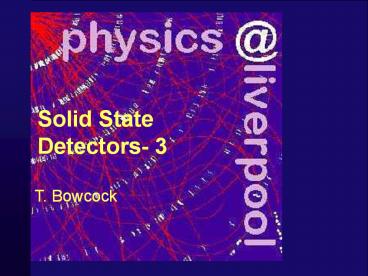Solid State Detectors- 3
Title: Solid State Detectors- 3
1
Solid State Detectors- 3
- T. Bowcock
2
Schedule
- 1 Position Sensors
- 2 Principles of Operation of Solid State
- Detectors
- 3 Techniques for High Performance Operation
- 4 Environmental Design
- 5 Measurement of time
- 6 New Detector Technologies
3
Techniques for High Performance Operation
- Strip Detectors
- Design and Fabrication Issues
- What to avoid!
4
Review...
- In the p-strip in n-bulk (p-in-n) detectors
- Vdep100V
- Energy to create electron hole pair is
- 3.6eV ( not 1.1eV-why? )
- Average energy lost/mm
- 39keV (108eh/ mm)
-V
Al
Si
-
5
Drift
- Electric field in Depleted region linear
- 300mm detector
- at 100V E3.0keV/cm
- Diffusion/Drift by multiple collisions
- Takes 7ns for es, 20ns for holes
Higher diffusion at low temps!
6
Ballistic Deficit
Charge lost is known as the ballistic deficit
Collection time
7
Strip Pitch and Readout Pitch and resolution
- Select it
d
Single strip has d/?12
d/10
8
Choosing the Pitch
- Why not make it infinitely small
- transverse diffusion
- 10-20 microns
- construction
- readout electronics!
- Readout pitch
- not necessarily the same as diode pitch (cost)
75mm readout (25mm diode)
9
Intermediate Strips
- Work by capacitive coupling
- induced current/charge is that seen by the
electrons and holes (not a post-facto charge
sharing!) - Why no broader strips ?
- Interstrip capacitance lt1pF
Need field map!
10
Intermediate Strips?
- Loose signal
- An option if
- limited by resources
- little noise in electronics (slow es)
- Optimal choice is
- readout each strip
- pitch and width evaluated by FEA
- pitch between 20 microns and 100 microns
11
Performance
50 mm with intermediate strip
25mm readout
12
Resolution
- Test your resolution
- series of particles of known position
- testbeam telescope
- cosmic telescope
- longwavelength laser
13
Checking Resolution
Optical fiber
- Tests
- laser
- problems?
- transparancy
- cosmics
- slower
- testbeam
- expensive
- labour intensive
Focus to 5 mm
1064nm Si transparent
14
Two Track Resolution
- Reconstruction position as a function of
proximity of one track to another
15
Occupancy
- Best to reduce occupancy
- 1 considered the benchmark
- 10 too high
- Reduce the length of strips
- usually about 6cm
- reduce to 1cm for example
16
AC Coupling Revisited
- e0.34pF/cm
- 200nm oxide
- 10pF/cm
- Greater than Interstrip capacitance
- Electronics at ground!
17
Double Sided
- Needs AC coupling!
- Correlation of signals
- Strips can run opposite directions
- 2D style r/o
-V
- -
- -
0V
18
Double Sided Detector
- Would like electronics at one end
- Can get correlated measurement (E) giving x/y
measurement - Reduces fakes
- Punchthrough
19
Double Metal
- Add another routing layer
- more processing
via
- Expense can double
- Built in stresses in SiO2 can warp Si wafer
badly
20
Double Metal
Can also use to route on single sided detectors
21
Strips
22
Example of Double Metal Detectors
- LHCb prototypes
23
Bond Pads
- Structure you will often see
Typically 80 by 200 microns
24
n-strip detectors
- We can make single sided n-strip detectors (note
depletion!)
25
Field Plates
- MOS structures
26
p-stops
- Individual p-stops
27
Operating Voltage
- High (overvoltage is desirable)
- 250V
- reduced ballistic deficit
- BUT
- introduces very high field regions?
- Avalanche will set in if field exceeds 30V/m
28
Analysis of structure
29
Electric Field
Sample field map
30
Guard Rings
- Reduce fields at edge
31
Micro-Discharges
- Discharges may be seen as in increase in the
noise with voltage
32
Si Choices
- Resistivity
- n-type
- p-strips
- n-strips
- double sided
- p-type
- Crystal orientation
33
Benchmark measures
- Charge Collection Efficiency
- Partial Depletion
- Ballistic Deficit
34
Fabrication
- Control of all steps critical
- Of special interest
- resistor values
- implantation
- oxide quality for breakdown
- quality of lithography
35
Quality Assurance
- Job of the physicist is to measure all the key
parameters of the detectors - IV and CV
- interstrip capacitance
- resistor values
- lightspot response
36
Readout Chain
37
F/E Electronics
- Binary vs Analog
- Amplifier Characteristics
- rise time and falltime
- undershoot
- Digital Performance
- pipeline logic
- Noise
38
Hybrid Design
39
Noise
- Hybrid is often a source of noise
- bad grounding for electronics
- bad grounding for supplies to detector
- sensor,analog and digital all connected
- The detector, f/e electronics and the hybrid
should be regarded as one unit or MODULE
40
Module and Mounting
41
Material Budget
- Ideally should be as low as possible
- avoid high mass materials
- gold
- Good detector about 1 of a radiation length
42
Example DELPHI barrel
43
Offline Analysis
- Can give improvement in resolution
w
L
R
Only true if charge uniform and if the width of
the cluster matches the strip width In general we
have a Gaussian distribution of width determined
by the diffusion coefficient (for normal
incidence)
d
x
44
Offline
- Corrections for the angle of the track and the
known (measured) charge sharing can give great
improvement - 20 to 30 in the case of 25 microns pitch
detectors - Good software must accompany good hardware
- Removal of deltas
45
7 things to avoid
- Picking the wrong technology
- Picking the wrong manufacturer()
- Not enough Quality Control
- Bad design limiting operation
- Noise in system
- Treating sensor and hybrid separately
- Bad analysis
46
Summary
- We have all the elements now to think about real
detectors in real environments - design issues
- noise problems
- See how we design a detector for LHCb































